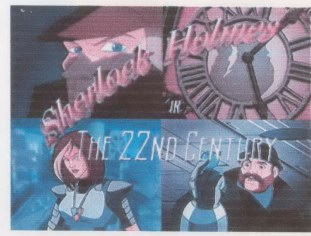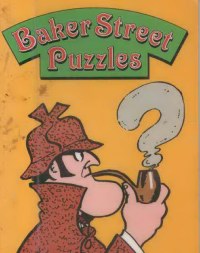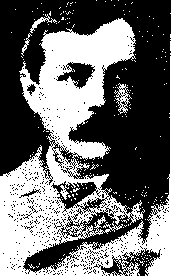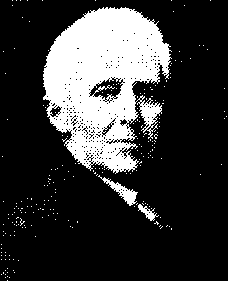The Norbury
 Chronicle
Chronicle"Nothing is concealed that will not be revealed." (Mark 4:22)
SIG NEWS
The most exciting news in the SIG, at least for your beloved editor, friend@Norbury, is that he has become editor for two of the Sherlock Holmes' sites at tvtome.com -- and would appreciate SIG members' help. If you have any information on the '54-55 "Sherlock Holmes" series staring Ronald Howard and Howard Marion-Crawford (particularly episodes 2, 4, 6-8, 12-13, 15, 17-19, 21-23, 25, 27, 29, 31-34, 36-39) or the '99 animated Canadian "Sherlock Holmes in the 22nd Century" series (particularly episodes 4-5, 7, 9, 12, 14, 17-26.)


BOOKS
We have also been having fun with the above '94 book by Tom Bullimore. The "puzzles" include logic problems, simple cryptograms, trick questions, even mathematical word problems.
The very first one seems to answer the controversial question, asked by Watson, of when Holmes' birthday was, with his "You tell me, Watson. The day before yesterday I was 32, and next year I will be 35!" Watson not unexpectedly responds with, "Impossible!" With a bit more thought you should be able to think of the one date on which this could be truthfully said.
This most likely answer however does make the assumption that it was the Gregorian calendar year being referenced. If Holmes was referring to the Jewish or Moslem or Julian calendar years, the answer would be something else and even if he was not it still leaves unanswered the question of the year Holmes' was born.
It might be instructive to go through one of them to see what a lot of deduction can be derived from what seems a small amount of information. (Bullimore gives only the answer, not how it was arrived at.)
At Oxbridge again, Holmes is dealing with a student thief, one of five students with the surnames Bothwell, Carter, Daniels, Knight and Simpson, Christian names John, Peter, Robert, Tom and William, and majoring in biology, economics, history, languages and law, in rooms 43 to 47. 1.William resides in the room to the left of the econ major.
2. Bothwell and John have even numbered rooms.
3. The law student's in 45.
4. Neither Tom or John know Knight very well.
5. Knight is between the biology student and Carter the econ major.
6. Daniels in 47 is next to Robert the biology major.
7. Tom, the language major, is two rooms to the right of the thief.
From just clues 3 and 6, the clues with room numbers, we have 34/80 or 45% of the possibilities determined as true or false already.
B
|
C
|
D
|
K
|
S
|
John
|
Peter
|
Rob
|
Tom
|
Will
|
Bio
|
Econ
|
Hist
|
Lang
|
Law
|
THIEF
|
|
43
|
False
|
False
|
False
|
False
|
||||||||||||
44
|
False
|
False
|
False
|
False
|
||||||||||||
45
|
False
|
False
|
False
|
False
|
False
|
False
|
True
|
|||||||||
46
|
False
|
False
|
False
|
True
|
False
|
False
|
True
|
False
|
False
|
False
|
False
|
|||||
47
|
False
|
False
|
True
|
False
|
False
|
False
|
False
|
False
|
From 5 we then have 12 more for 46/80 or 57.5%, more than half.
B
|
C
|
D
|
K
|
S
|
John
|
Peter
|
Rob
|
Tom
|
Will
|
Bio
|
Econ
|
Hist
|
Lang
|
Law
|
THIEF
|
|
43
|
False
|
False
|
False
|
False
|
False
|
|||||||||||
44
|
False
|
True
|
False
|
False
|
False
|
False
|
False
|
True
|
False
|
False
|
False
|
|||||
45
|
False
|
False
|
False
|
True
|
False
|
False
|
False
|
False
|
False
|
False
|
True
|
|||||
46
|
False
|
False
|
False
|
True
|
False
|
False
|
True
|
False
|
False
|
False
|
False
|
|||||
47
|
False
|
False
|
True
|
False
|
False
|
False
|
False
|
False
|
False
|
From 2 and 4, the John clues, we get 17 more for 63/80 or 78.75%.
B
|
C
|
D
|
K
|
S
|
John
|
Peter
|
Rob
|
Tom
|
Will
|
Bio
|
Econ
|
Hist
|
Lang
|
Law
|
THIEF
|
|
43
|
False
|
False
|
False
|
False
|
True
|
False
|
False
|
False
|
False
|
False
|
||||||
44
|
False
|
True
|
False
|
False
|
False
|
True
|
False
|
False
|
False
|
False
|
False
|
True
|
False
|
False
|
False
|
|
45
|
False
|
False
|
False
|
True
|
False
|
False
|
False
|
False
|
False
|
Falsealse
|
False
|
False
|
True
|
|||
46
|
True
|
False
|
False
|
False
|
False
|
False
|
False
|
True
|
False
|
False
|
True
|
False
|
False
|
False
|
False
|
|
47
|
False
|
False
|
True
|
False
|
False
|
False
|
False
|
False
|
False
|
False
|
Clue 7 tells us that which ever of the end rooms Tom is in, whichever direction left or right are and whichever major is William's the thief must be Peter Knight the law student in 45. If that's so then William must be in 43 and Tom in 47, to the right of 45.
B
|
C
|
D
|
K
|
S
|
John
|
Peter
|
Rob
|
Tom
|
Will
|
Bio
|
Econ
|
Hist
|
Lang
|
Law
|
THIEF
|
|
43
|
False
|
False
|
False
|
False
|
True
|
False
|
False
|
False
|
False
|
True
|
False
|
False
|
False
|
False
|
||
44
|
False
|
True
|
False
|
False
|
False
|
True
|
False
|
False
|
False
|
False
|
False
|
True
|
False
|
False
|
False
|
False
|
45
|
False
|
False
|
False
|
True
|
False
|
False
|
True
|
False
|
False
|
False
|
False
|
False
|
False
|
False
|
True
|
True
|
46
|
True
|
False
|
False
|
False
|
False
|
False
|
False
|
True
|
False
|
False
|
True
|
False
|
False
|
False
|
False
|
False
|
47
|
False
|
False
|
True
|
False
|
False
|
False
|
False
|
False
|
True
|
False
|
False
|
False
|
False
|
False
|
Clue 1 gives the final 4 or 5%.
B
|
C
|
D
|
K
|
S
|
John
|
Peter
|
Rob
|
Tom
|
Will
|
Bio
|
Econ
|
Hist
|
Lang
|
Law
|
THIEF
|
|
43
|
False
|
False
|
False
|
False
|
True
|
False
|
False
|
False
|
False
|
True
|
False
|
False
|
True
|
False
|
False
|
False
|
44
|
False
|
True
|
False
|
False
|
False
|
True
|
False
|
False
|
False
|
False
|
False
|
True
|
False
|
False
|
False
|
False
|
45
|
False
|
False
|
False
|
True
|
False
|
False
|
True
|
False
|
False
|
False
|
False
|
False
|
False
|
False
|
True
|
True
|
46
|
True
|
False
|
False
|
False
|
False
|
False
|
False
|
True
|
False
|
False
|
True
|
False
|
False
|
False
|
False
|
False
|
47
|
False
|
False
|
True
|
False
|
False
|
False
|
False
|
False
|
True
|
False
|
False
|
False
|
False
|
True
|
False
|
False
|
Another sort of logical puzzle, a metapuzzle, is this one of determining which one of the suspects in Lord Hall's stabbing truthfully answered the question, "Which one of you is the murderer?" and then which one actually is the murderer.
Johnstone: "It wasn't me."
Kline: "It was Low."
Low: "It was Johnstone."
Morton: "It definately wasn't."
If Johnstone or Kline or Morton were telling the truth at least one of the others would also have to be telling the truth. If Low were however the other three must not be, so Johnstone is the murderer.
===================
One of the mathematical puzzles mentions Holmes as a member of the Criminologist's Club. It so happened that the proposal that all members equally split the 2040-pound cost of repairs to the clubhouse was unanimously passed, but that four members then resigned. (It doesn't say whether Holmes was one of them. He may have just joined temporarily as part of one of his investigations.) Thus forced the remaining members to pay an extra 17 pounds each.
In algebraic notation the problem of how many members the club had before and after the vote would be: 2040/x + 17 = 2040/(x - 4) or (x - 24)(x - 20) = 0. In our Sleuth Publications, Ltd.'s '82 London Directory we don't find a Criminologist Club listed, but do find detectives Barker, Francis Baird, Martin Hewitt, Moser, Paschal and Tod listed and the possibly related names George Barker, Jane Baird, Tod Lennox and Tod Samrick, for a likely 10 of the 20.
Another refers to the little puzzled over ages of Inspector Lestrade and Mrs. Hudson. It claims that when the digits of her age reversed were his, the difference between their ages was 1/11th of their sum. Assuming they're both below 100, that's (10x + y) - (10y + x) = (10x + y + 10y + x)/11 = 9x - 9y = x + y or 4x = 5y, so that x = 5 and y = 4. One was 54 and the other 45.
*******************
Enough of logic, here's the paralogical puzzles:
1. How could two bank robbers born of the same parents, on the same day of the same year not be twins?
2. What is the relationship between two people if one is the father of the other's son?
3. How can you form one word only by rearranging the letters YONWOONDLER?
4. What time can be read the same right-side up as up-side down?"
PORLOCK'S PUZZLES
The puzzles this issue are also from Bullimore, cryptograms and sequences (which he dubiously attributes to Moriarty and none to poor Porlock. Or were the two one?!)
1. J XJMM SPC UIF CBOL PG FOHMBOE UPOJHIU. MPSJBSUZ. 2. JFMAMJJA_? 3. OTTFFSS_? 4. R DROO PROO RMHKVXGLI OVHGIZWV FMOVHH BLF YIRMT UREV GSLFHZMW KLFMWH, NLIRZIGB. 5. 14-22-22-7 14-22 26-7 16-18-13-20-8 24-9-12-8-8 8-7-26-7-18-12-13, 19-12-15-14-22-8. 6. LTBMTOORARNIIADGLIOHNNTON 7. YTRAIROM SI GNIDLOH EM RENOSIRP TA NOSIDDAM NOISNAM NOSTAW. 8. 31 28 31 30 __? 9. 7738 317537 10. 20 24 6 2 8 __? 11. SOLO PAIRS HASTEN AVENGE 12. 23406 306 13. 19 16 11 13 9 __?
DETECTIVE DOYLE


We ought to make some mention of the PBS "Mystery" series, "Murder Rooms" featuring the characters Dr. Arthur Doyle and Dr. Joseph Bell. We call them characters because they seem to do so much more detective work than actual medical work. It was a bit too realistic and mid-Victorian. We are rather more used to the Master's variety of cases -- burglaries, forgeries, fraud, jewel theft, bank robbery, blackmail, rather than just one grisly murder after another, though the title ought to have been a caveat. (We have to admit that some of them were rather intriguing though.)
What do other viewers out there think? It doesn't measure up to the Canon, of course. Nothing does. We'd say that compared to the usual fare of period British murder mysteries it was rather good.
In "I Hear of Sherlock Everywhere Since You Became His Chronicler" William S. Baring-Gould quotes Doyle and Bell each claiming the other as a Sherlock Holmes. The case is better supported for Bell's claim. "Save for his remarkable gift of deduction", Baring-Gould writes "Bell was never once able, in real-life crime cases, to show that he possessed any Holmesian powers; Conan Doyle, on the other hand, as we shall see, played a part in the investigation of many real-life crimes; certainly he was consulted by Sir Bernard Spilsbury, H. Ashton-Wolfe, and other criminologists and police officials."
Baring-Gould refers to Doyles' involvement in the Mrs. Rome case (results unknown), the missing Dane case (solved), the Thorne murder case, the "Brides-in-the-Bath" serial murders case, the George Edali (1906-7) and Oscar Slater (1909-27) cases.
100 YEARS AGO
air conditioning, disc brakes invented
tyranosaurus discovered in Hell Creek, Mont.
A Trip to the Moon by Jules Verne, Savage Life in New Guinea by C. W. Abel, The Adventures of Romney Pringle by Edgar Allen Poe published
"Won't You Come Home, Bill Baily" popular
Holmes less busy than in 8 years (SOLI 1:A), writes (ABBE 7:B)
Holmes refuses knighthood, Doyle accepts
Dr. William Bates disappearance
Lady Beatrice Falder death cover-up
June 26-7 discovery of Prescott's plates closes Garrideb museum (3GAR)
Aug. 10 black sea monster sighted, New York City, NY
Sept. 3 Baron Adelbert von Gruber blinded (ILLU)
Sept. 24-5 Gorgiano murder case (REDC)
Oct. 4 60-foot humped sea monster seen by yacht, Oslo fjord, Norway
Gavin Brend suggested in My Dear Holmes that John Clay was behind the “certain devilish ingenuity” in the Garrideb scam, but we'd suspect that more infamous criminal genius for hire if he wasn't presumed dead 11 years before.
Holmes' “small, but ever efficient organization”, perhaps the same “flatfoot” Agency of SUSS (1896), continues, started, it seems, after Watson sold his practice to Dr. Vernier.
Rolfe Boswell in “Squaring the Red Circle” points out that the mysterious lodger tore off the corner of the notepaper because by this date the use of fingerprinting by Scotland Yard (for the past year) had become publicized in the press. Prof. Louis E. Lord objected to the Lucca code's 20 = T since the twentieth letter of the Italian alphabet is S. The use of nulls, like the K, W, X, and Y missing in the Italian alphabet, is just the sort of thing that code makers want, to delay, as they did here, the breaking of the code. Our own experiments with making flashes (by cutting off the candlelight rather than waving the candle) were considerably quicker than S. F. Blake's 4 ¾ minutes to transmit the 4 ½ word message.
ANSWERS
Assuming the Gregorian calendar, Holmes could, of course, only have been referring to his birthday on Dec. 31 on Jan. 1. He'd be a year older before the year ended and another year older the next year.
1. They could be triplets, quadruplets or from some other multiple birth.
2. Lovers, hopefully spouses.
3. Bullimore gives the answer as ONE WORD ONLY, though NEWLY-ON-DOOR referring to the knob on a door newly fastened onto its frame and NEW-OR-DOONLY referring to writing either original or at least like Doon, a Dune imitation, might also work
4. Bullimore gives the answer as NOON, but | | : | | also works in the military's 24-hour day notation
1. A = B, B = C, etc. substitution cipher: "I will rob the Bank of England tonight. Moriarty." So obvious as to be an obvious attempt at misdirection.
2. The months' initials: ...SOND
3. The integers' initials: ...ENTETTFFSSENTTTT...
4. A = Z, B = Y, etc. substitution cipher: "I will kill Inspector Lestrade unless you bringfive thousand pounds, Moriarty."
5. A = 26, B = 25, etc. substitution cipher: "Meet me at King's Cross Station. Holmes"
6. transposition cipher with words written vertically and then read horizontally.
L T B M T
O O R A R
N I I A
D G L I
O H N
N T
O
N
7. transposition cipher with words' letters reversed: "Moriarty is holding me prisoner at Maddison mansion, Watson."
8. days in months: ...31 30 31 31 30 31 30 31 31 28 ...
9. numbers turned up-side down to resemble letters of the name: LESLIE BELL
10. alternately multiplying, adding, dividing and subtracting by 4: 12 3 -1 -4 0 0 -4 -16 -12 -3 -6 ...
11. city anagrams: Oslo Paris Athens Geneva
12. mirror writing for Joe Jones
13. alternately subtracting 6, 5, 4, ... and adding 3, 2, ...: 10 7 7 5 6 5 7 7 10 ...